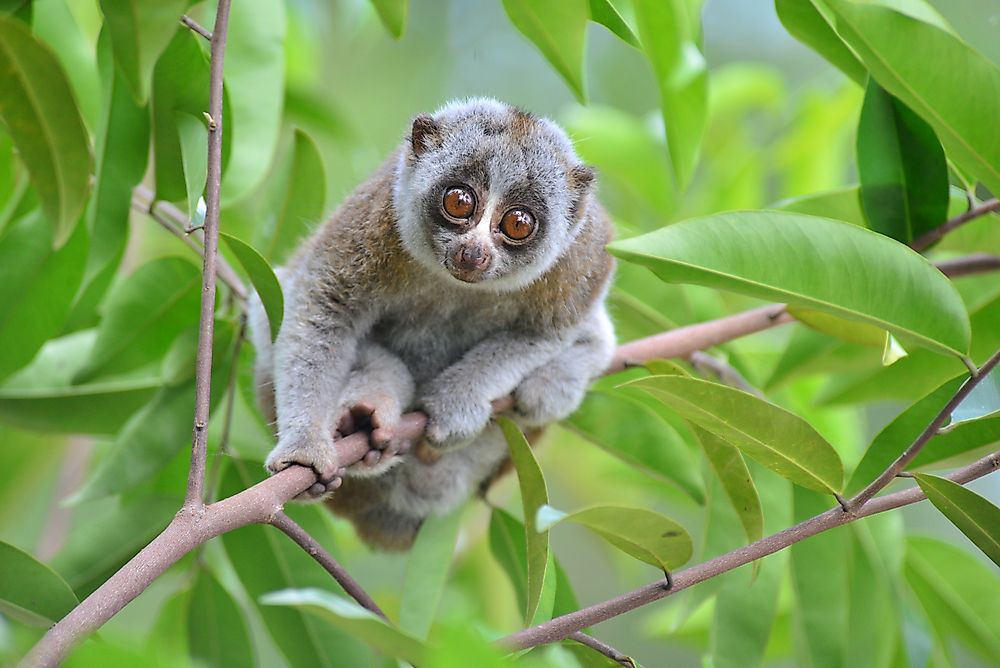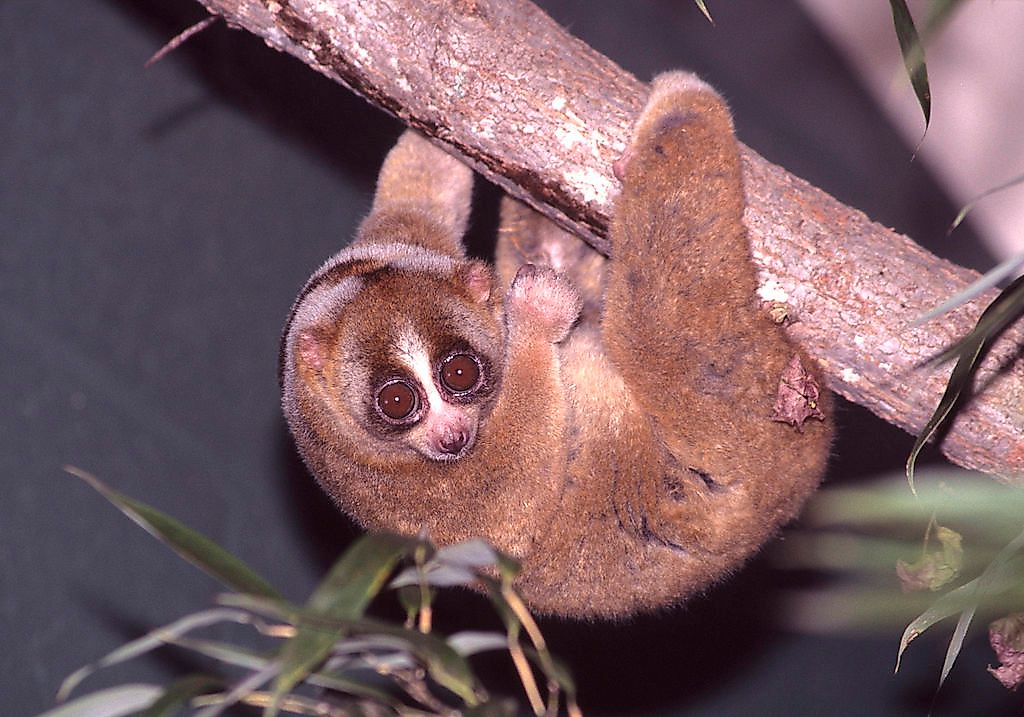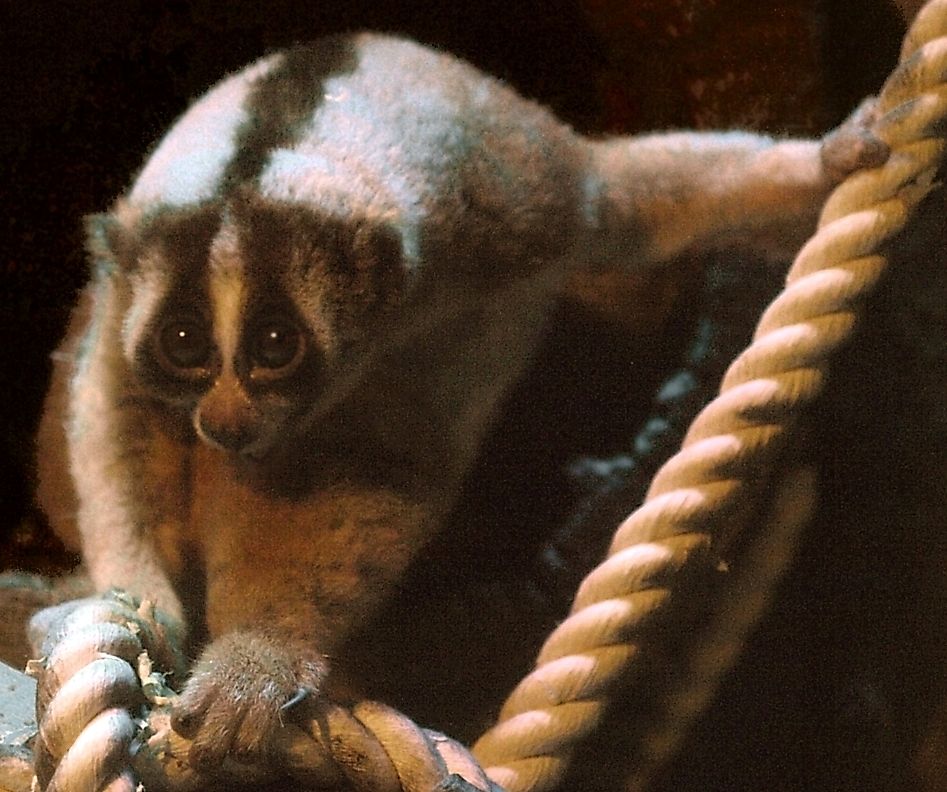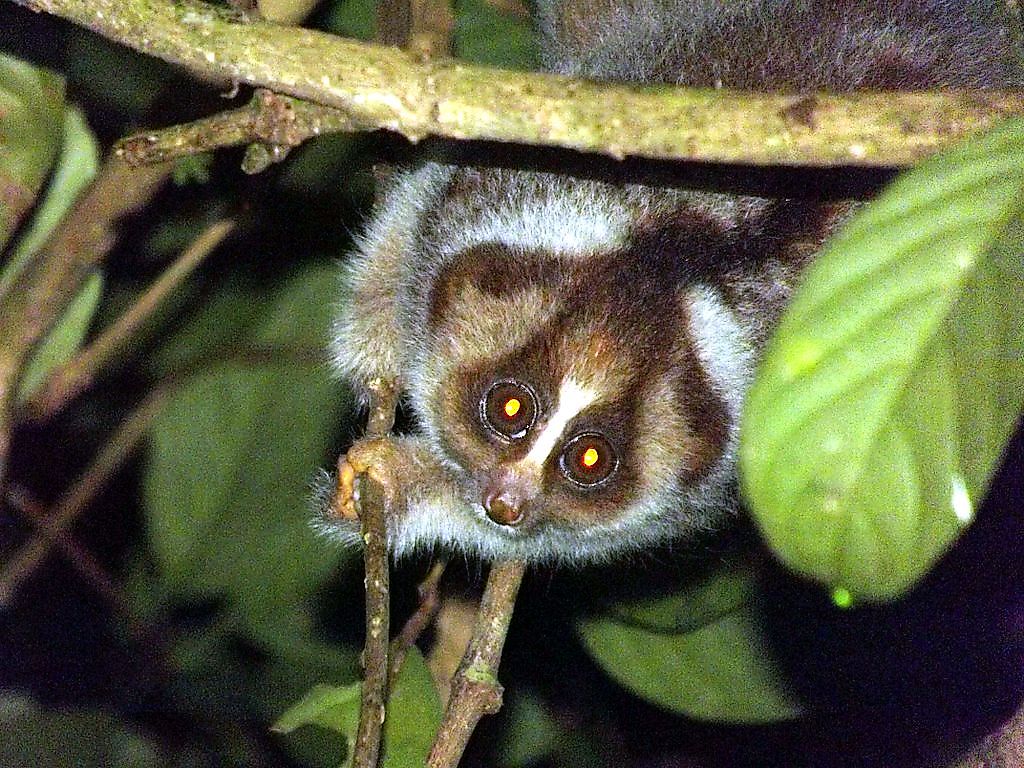How Many Species Of Slow Lorises Live In The World Today?

Slow lorises are a group of primates of the genus Nycticebus. These animals are found in parts of islands of Southeast Asia, the Indian subcontinent, and Indochina. These animals are nocturnal and arboreal in nature and generally, have an omnivorous diet. The slow lorises of the world face a considerable threat to their existence due to indiscriminate hunting, capturing of infants for the illegal pet trade, and habitat destruction.
8. Bangka Slow Loris
The Bangka slow loris (Nycticebus bancanus) inhabits the southwestern Bornean island of Bangka. The animal is identified by its crimson-red colored fur on the back and light-colored features on the face. This species of slow loris is arboreal and nocturnal in nature. It is an omnivore that feeds on insects, nectar, fruit, tree gum, etc. The Bangka slow loris has a toxic bite. It is classified as “Vulnerable” by the IUCN as illegal hunting and habitat loss threatens the survival of the species.
7. Bengal Slow Loris
The Nycticebus bengalensis or the Bengal slow loris is a slow loris species that is native to Indochina and the Indian subcontinent. The animal inhabits both deciduous and evergreen forest habitats within its range. This species has the most extensive range among all slow loris species. It also has the largest size. The length of the Bengal slow loris varies between 26 and 38 cm from head to tail. The chemical composition of the toxin secreted by this slow loris species is different from those of the other species. The diet of the Bengal slow loris consists of fruits, insects, snails, tree sap, and gum, etc. It is nocturnal and arboreal in nature. The species is classified as “Vulnerable” on the Red List of IUCN. It has gone locally extinct in several regions. Poaching and illegal logging in its habitat have severely decreased the population of this species.
6. Bornean Slow Loris
The Nycticebus borneanus or the Bornean slow loris is native to Borneo, Indonesia. The dark, contrasting facial features and unique markings on the face help to distinguish this species of slow loris. The food habit of this species is similar to that of the others mentioned above. It also has a toxic bite and is nocturnal and arboreal in nature. The species is also classified as “Vulnerable” since it has suffered for decades from the ill effects of the illegal wildlife trade and habitat loss on their population.
5. Sunda Slow Loris

Also known as the greater slow loris, the Sunda slow loris (Nycticebus coucang) is native to the forests of Indonesia, Malaysia, Singapore, and Thailand. This species of slow loris prefers to inhabit evergreen forests within its range. It feeds on sap, nectar, arthropods, etc. The length of the species varies from 27 to 38 meters from head to tail. It is generally solitary by nature and has a very low metabolic rate. The species suffers from habitat loss and hence is labeled as a “Vulnerable” species by the IUCN.
4. Javan Slow Loris

The Javan slow loris (Nycticebus javanicus) is native to the island of Java, Indonesia where it inhabits primary and secondary forest habitats. The species is distinguished by the presence of a white diamond pattern on its forehead. The animal measures about 293 mm from head to tail. The Javan slow loris is also an omnivore and feeds on eggs, lizards, fruit, tree gum, etc. It is usually a solitary creature but occasionally resides in small groups. It is the most threatened species of slow loris and is also listed in the 2010 list of "The World's 25 Most Endangered Primates.” Despite protective measures being implemented, the Javan slow loris continues to be poached for traditional medicine and captured for the exotic pet trade. It is thus classified as a “Critically Endangered” species by the IUCN.
3. Kayan River Slow Loris

The Kayan River slow loris (Nycticebus kayan), named after the Kayan River which flows through the habitat of the species, is native to the Borneo island of Indonesia. The pattern of stripes of its facial markings and the highly contrasting black and white features of its face helps to distinguish the Kayan River slow loris from other slow lorises. The slow loris has a food habit similar to the species mentioned above. Habitat loss and illegal wildlife trade threaten the Kayan river slow loris populations. It is a “Vulnerable” species according to the IUCN.
2. Philippine Slow Loris
The Philippine slow loris (Nycticebus menagensis) is found in the Sulu Archipelago, Philippines, and Borneo, Indonesia. It is one of the smallest species of slow loris and weighs only 265 to 300 kg. The pale red to golden fur of the loris easily distinguishes it from the rest of the slow loris species. This arboreal and nocturnal creature is difficult to locate. Although it is omnivorous in nature, it is believed it is more inclined towards an insectivorous diet. IUCN labels the Philippine slow loris as a “Vulnerable” species.
1. Pygmy Slow Loris
The pygmy slow loris (Nycticebus pygmaeus) inhabits forests to the east of the Mekong River. The range of the species covers parts of China, Vietnam, Cambodia, and Laos. The pygmy slow loris lives in a wide variety of habits like evergreen, semi-evergreen, and tropical dry forests. These slow lorises prefer to live in groups with a few offsprings. The length of the animals ranges from 19 to 23 cm. The tail is very short. The species’ diet includes insects, nectar, fruits, etc. The animal is classified as “Vulnerable” by the IUCN since its population is vulnerable to habitat destruction, hunting, and the illegal pet trade.











